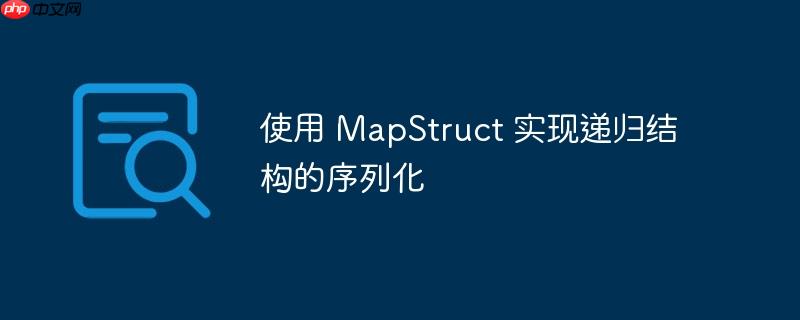
本文档介绍了如何使用 MapStruct 库来序列化具有递归结构的 Java 对象,例如树形结构。通过定义多个 Mapper 接口,并结合 @Mapping 注解,可以优雅地将包含嵌套列表的实体类转换为对应的响应类,从而简化 API 响应的构建过程。
在开发 Java Web 应用程序时,经常需要将内部数据模型转换为外部 API 响应格式。对于具有递归结构的数据模型,例如树形结构,手动编写序列化逻辑会变得非常繁琐。MapStruct 是一个代码生成器,可以简化不同类型之间的映射。本文将介绍如何使用 MapStruct 来序列化包含递归结构的 Java 对象。
首先,定义需要映射的实体类和对应的响应类。以树形结构为例,包含 Tree 和 Leaf 两个实体类,以及对应的 TreeResponse 和 LeafResponse 响应类。
import lombok.*;
import lombok.experimental.FieldDefaults;
import java.util.List;
import static lombok.AccessLevel.PUBLIC;
@Builder
@Getter
@AllArgsConstructor
@FieldDefaults(level = PUBLIC)
public class Tree {
String name;
List<Leaf> leafs;
}import lombok.*;
import lombok.experimental.FieldDefaults;
import java.util.List;
import static lombok.AccessLevel.PUBLIC;
@Builder
@Getter
@AllArgsConstructor
@FieldDefaults(level = PUBLIC)
public class Leaf {
String name;
List<Leaf> children;
}import lombok.*;
import lombok.experimental.FieldDefaults;
import java.util.List;
import static lombok.AccessLevel.PUBLIC;
@Getter
@Setter
@FieldDefaults(level = PUBLIC)
public class TreeResponse {
String name;
List<LeafResponse> leafs;
}import lombok.*;
import lombok.experimental.FieldDefaults;
import java.util.List;
import static lombok.AccessLevel.PUBLIC;
@Getter
@Setter
@FieldDefaults(level = PUBLIC)
public class LeafResponse {
String name;
List<LeafResponse> children;
}为了实现 Tree 到 TreeResponse 以及 Leaf 到 LeafResponse 的映射,需要定义两个 MapStruct Mapper 接口。关键在于,需要一个单独的 Mapper 接口来处理 Leaf 及其子节点的递归映射。
import org.mapstruct.Mapper;
import org.mapstruct.Mapping;
@Mapper
public interface TreeMapper {
@Mapping(target = "name", source = "entity.name")
TreeResponse map(Tree entity);
}import org.mapstruct.Mapper;
import java.util.List;
@Mapper
public interface LeafMapperSecond {
LeafResponse map(Leaf entity);
List<LeafResponse> map(List<Leaf> entity);
}需要注意的是,LeafMapperSecond 接口需要定义两个 map 方法,一个用于映射单个 Leaf 对象,另一个用于映射 Leaf 对象的列表。MapStruct 会自动处理列表的递归映射。
为了验证映射是否正确,可以编写一个测试用例。该用例创建一个包含嵌套 Leaf 对象的 Tree 对象,然后使用 MapStruct 将其映射到 TreeResponse 对象,并验证映射结果。
import org.junit.jupiter.api.Test;
import org.mapstruct.factory.Mappers;
import java.util.ArrayList;
import java.util.Arrays;
import java.util.List;
import static org.junit.jupiter.api.Assertions.assertEquals;
import static org.junit.jupiter.api.Assertions.assertNotNull;
public class MapstructTest {
private TreeMapper treeMapper = Mappers.getMapper(TreeMapper.class);
@Test
public void test() {
List<Leaf> leafs = new ArrayList<>();
leafs.add(Leaf.builder().name("Leaf 1").build());
leafs.add(
Leaf.builder()
.name("Leaf 2")
.children(
Arrays.asList(
Leaf.builder()
.name("Leaf Children 1")
.children(
Arrays.asList(
Leaf.builder()
.name("Leaf Children 1.1")
.build(),
Leaf.builder()
.name("Leaf Children 1.2")
.build()))
.build(),
Leaf.builder().name("Leaf Children 2").build()))
.build());
Tree tree = Tree.builder().name("tree name").leafs(leafs).build();
TreeResponse treeResponse = treeMapper.map(tree);
assertEquals(treeResponse.name, "tree name");
assertEquals(treeResponse.leafs.size(), 2);
LeafResponse leafWithChildren =
treeResponse.leafs.stream()
.filter(l -> l.name.equals("Leaf 2"))
.findFirst()
.orElse(null);
assertNotNull(leafWithChildren);
assertEquals(leafWithChildren.getChildren().size(), 2);
LeafResponse leafWithSubChildren =
leafWithChildren.children.stream()
.filter(l -> l.name.equals("Leaf Children 1"))
.findFirst()
.orElse(null);
assertNotNull(leafWithSubChildren);
assertEquals(leafWithChildren.getChildren().size(), 2);
}
}通过使用 MapStruct,可以轻松地实现具有递归结构的 Java 对象的序列化。通过定义多个 Mapper 接口,并结合 @Mapping 注解,可以优雅地将包含嵌套列表的实体类转换为对应的响应类,从而简化 API 响应的构建过程。这种方法不仅减少了手动编写的代码量,还提高了代码的可读性和可维护性。
以上就是使用 MapStruct 实现递归结构的序列化的详细内容,更多请关注php中文网其它相关文章!

每个人都需要一台速度更快、更稳定的 PC。随着时间的推移,垃圾文件、旧注册表数据和不必要的后台进程会占用资源并降低性能。幸运的是,许多工具可以让 Windows 保持平稳运行。

Copyright 2014-2025 https://www.php.cn/ All Rights Reserved | php.cn | 湘ICP备2023035733号